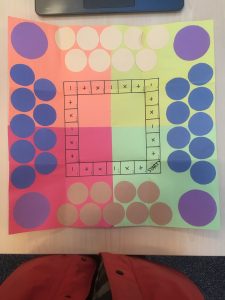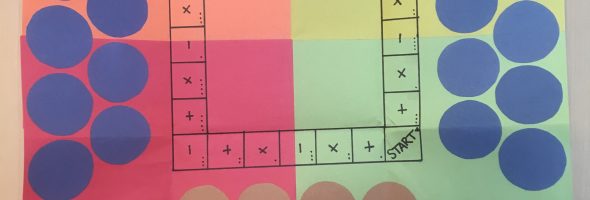
Tessa Webb
Introduction & Explanation
For my math object I have made a game. This game requires a die, a deck of cards, 4 player
pieces and 4 jars of small manipulative type objects (ie beans, beads, or buttons). The object of
the game is to collect points by moving around the board solving addition, multiplication or
subtraction problems. This game can be a 2,3, or 4 player game. To set up the game each player
puts their playing piece on the START square. The deck of cards goes in the middle of the game
board. Each player gets a jar of manipulatives (I have used beans, macaroni, chickpeas, and
coffee beans).
The players begin by each rolling the die, whoever rolls the highest number goes first. The first
player rolls the dice and moves their piece the number of spaces that corresponds to the number
shown on the die. The player will land on a square that has an addition, multiplication, or
subtraction sign on it. The student will take the deck, and turn over the top two cards from the
deck and place them in whatever order they would like to in front of them. That player then does
the operation that corresponds to the symbol on the square the players piece is on. For example if
I land on a square with a (+) on it I would find the sum of the two cards I flipped over. If the
student is on a subtraction symbol they will rearrange the numbers so they are taking the small
number away from the bigger number. Players may use their jar of beans to aid them with the
operation.
Students will then answer the question, if it is correct they receive the number of points that is
represented on the square their playing piece is on by the number of dots in the bottom left-hand
corner. The player counts out that number of beans and puts them in their purple circle. The
winner of the game is whoever collects 30 of their counting pieces in their purple circle first.
Rationale
I thought of this game because I wanted to use cards and a die to work on the basic math skills
that underlie all other math, specifically addition, multiplication, and subtraction. I thought a
game that used dice and cards would aid students in subitizing as it will familiarize them with the
common arrangements of numbers found on cards and dice. This game has a randomized point
system which I thought would add a small competitive component, but one that is fairly arbitrary
so students do not feel down hearted if they don’t win. This game is targeted for students in
grade 2 and 3.
Big Ideas:
– Development of computational fluency in addition and subtraction (Gr. 2)
– Development of computational fluency in addition, subtraction, multiplication, and
division of whole numbers requires flexible decomposing and composing (Gr. 3)
Curricular content and competencies:
This game contributes to student’s mental math strategies and patterning. Students have the
opportunity to practice multiplication, addition to 20, and subtraction of single or double digits.
This game provides opportunities for students to demonstrate different ways of communicating
mathematical ideas. It also provides an opportunity for students to increase their fluency in
addition, subtraction, and multiplication.
Use and Assessment
This would be a useful tool to have at a math station if you were doing learning centres in math.
If you, as the teacher, could play this game with students you would be able to assess how their
basic fluency and number sense is developing by watching them count, multiply, add, and
subtract throughout the game. As students play, the teacher could observe which students are
continually successfully and winning more rounds as they will have more opportunity to collect
points if they are successfully answering the questions. The visual representation of math
operations provides an opportunity to watch students demonstrate their mathematical thinking.
This would be a useful tool to provide students before teaching them division, as division
includes addition, subtraction, and multiplication. Having students demonstrating their thought
process as they work through problems will also help students who are struggling to understand
multiplication, addition, or subtraction.
Increasing the difficulty can be done by having students add, multiply, or subtract 2, 3 or 4 digit
numbers as well as division could be added in. There are opportunities for students to use the
game board and materials to make their own games. By leaving the game mostly unlabelled there
is room to find inspiration and other uses for the game and its materials. Using decks of cards
and dice also provide a variety of opportunities to change the game or make up a new game.

